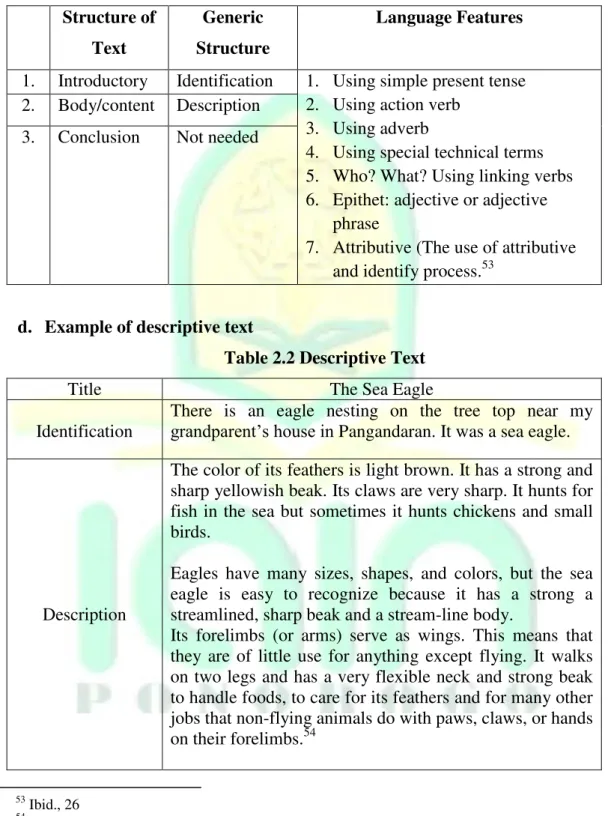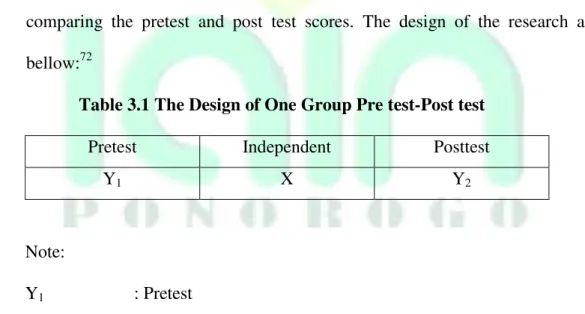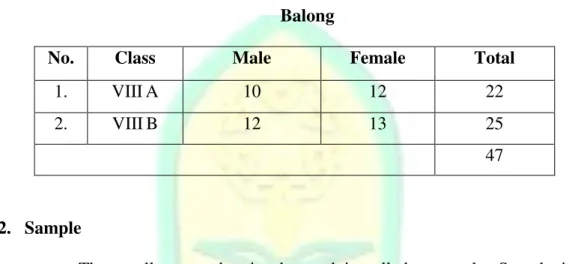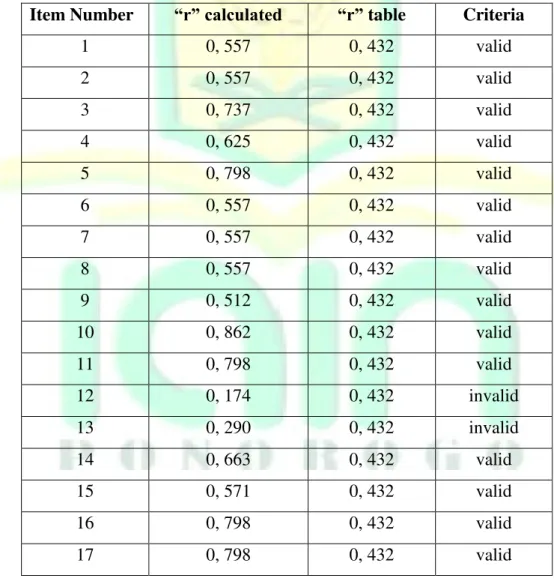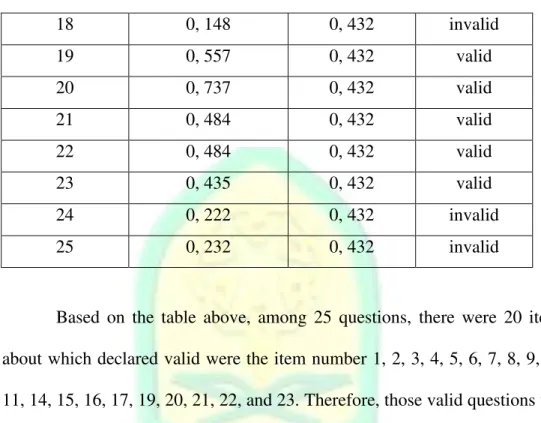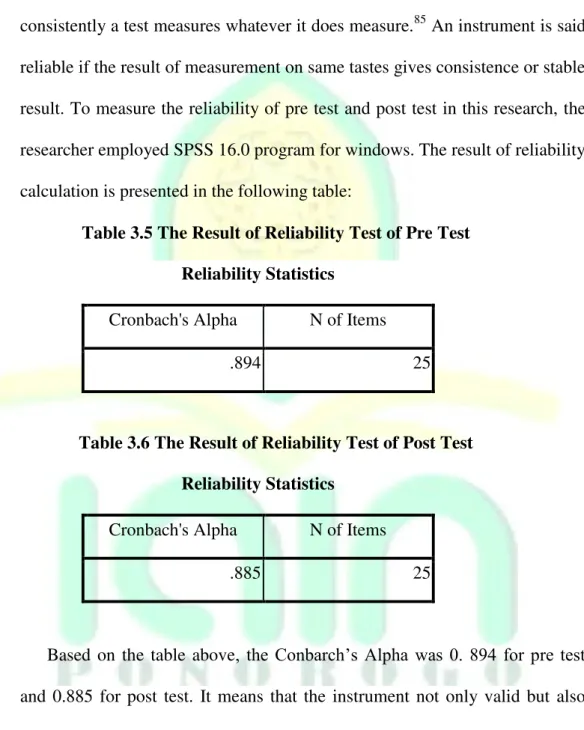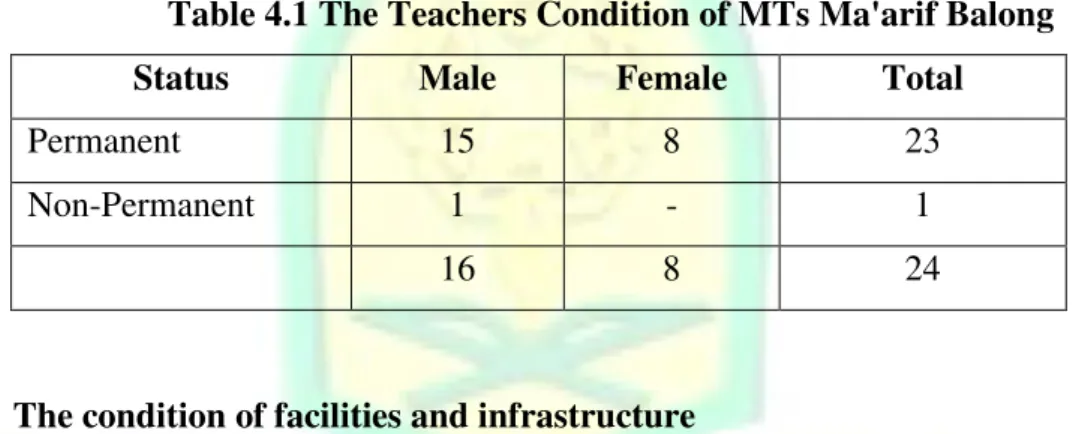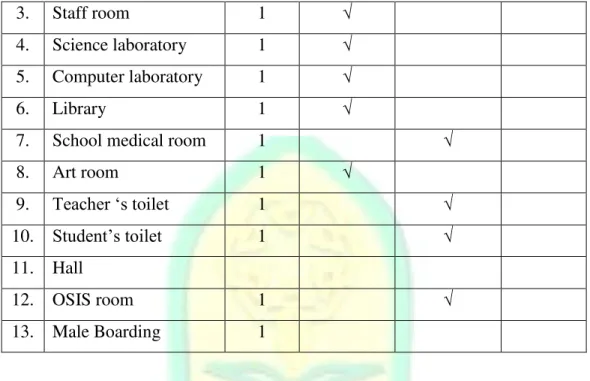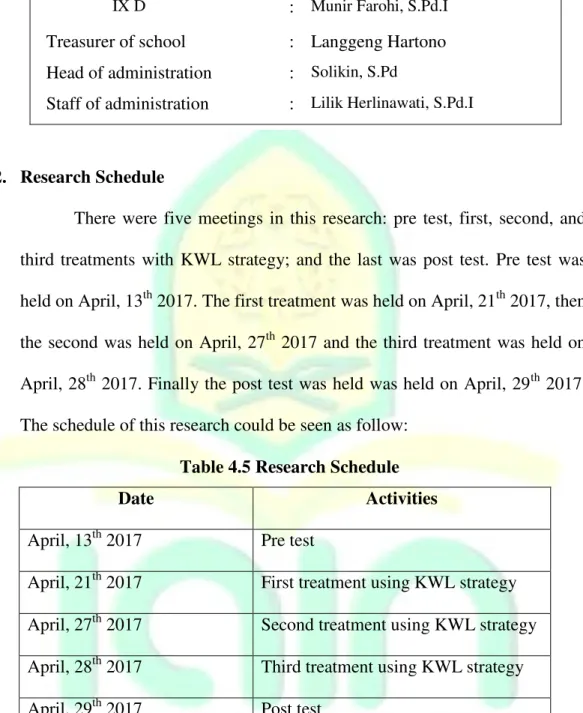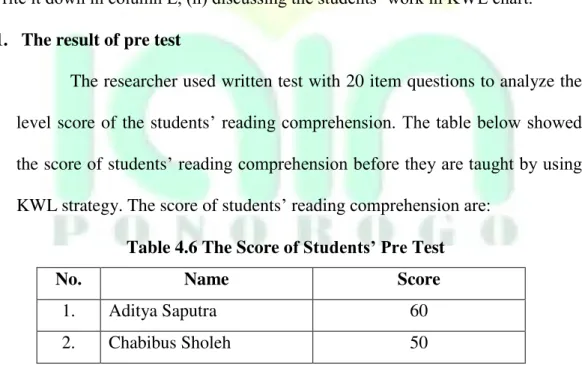1
THE EFFECT OF USING KNOW-WANT TO KNOW-LEARNED (KWL) STRATEGY ON STUDENTS’ READING
COMPREHENSION TO THE EIGHTH GRADE STUDENTS OF MTS MA’ARIF BALONG IN ACADEMIC YEAR 2016/2017
THESIS
Presented to
The State Institute of Islamic Studies of Ponorogo in partial fulfillment of the requirement for the degree of Sarjana in English Education
By
SRI WULANDARI NIM. 210913009
ENGLISH EDUCATION DEPARTMENT
TARBIYAH AND TEACHERS TRAINING FACULTY THE STATE INSTITUTE OF ISLAMIC STUDIES
(IAIN) PONOROGO
2017
ABSTRACT
Wulandari, Sri. 2017. The Effect of Using Know-Want to Know-Learned (KWL) Strategy on Students’ Reading Comprehension to the Eighth Grade Students of MTs Ma’arif Balong in Academic Year 2016/2017. Thesis, English Education Department, Tarbiyah and Teachers Training Faculty, The State Institute of Islamic Studies of Ponorogo, Advisor Nurul Khasanah, M.Pd
Key words: Know-Want to Know-Learned (KWL) and Reading Comprehension Reading is one of the important skills that should be acquired and learned by students in learning English. Reading is not only used in teaching and learning process but also in daily activity. More importantly, reading functions as a tool to access information. By reading, the students will get much information and knowledge that is very useful for them in learning process. To increase students‟
reading comprehension, the teacher needs suitable strategy to conduct in the classroom. KWL strategy is one of the strategies that can build the prior knowledge, develops predicting skills, and increase writing skills too.
The statement of the problem: Is there any significant difference on students‟
reading comprehension before and after using Know-Want to Know-Learned (KWL) strategy to the eighth grade students of MTs Ma‟arif Balong in academic year 2016/2017? The objective of the research is to know whether there is any significant difference on students‟ reading comprehension before and after using Know-Want to Know-Learned (KWL) strategy to the eighth grade students of MTs Ma‟arif Balong in academic year 2016/2017.
The design of this research was quantitative research. This research was pre experimental research. The researcher employed one group as pre test and post test design. In this case, the researcher used simple random sampling as technique in choosing the sample. The populations were 47 students and sample was 25 students.
Here, techniques of data collection applied by the researcher were documentation and test. To calculate the data, the researcher used SPSS 16 programs for Windows and to analyze the data the researcher employed T-test formula.
The result showed that the value of t0 between students reading comprehension before and after using Know-Want to Know-Learned (KWL) strategy was 4, 106. The result of computation based on T-test formula of 5% significant was 2, 06. t0 was higher than tt. So, Ha was accepted and H0 was rejected. It implies that, there is a significant difference on students‟ reading comprehension before and after using Know-Want to Know-Learned (KWL) strategy to the eighth grade students of MTs Ma‟arif Balong in academic year 2016/2017. It becomes important for the teacher to use a appropriate strategy in teaching English especially in teaching reading.
CHAPTER I INTRODUCTION
A. Background of the study
Reading is one of the important skills that should be acquired and learned by students in learning English. Reading is not only used in teaching and learning process but also in daily activity, for examples; reading a newspaper, magazine, book. More importantly, reading functions as a tool to access information. By reading, the students will get much information and knowledge that is very useful for them in learning process. Reading is an activity that has purpose. According to Harmer, reading is useful for other purposes too; any exposure to English (provided students understand it more or less) is a good thing for language students.1
In addition, according to Nunan, reading is a fluent process of readers combining information from a text and their own background knowledge to build meaning. It means that it is an activity to find information and produce the meaning from sentences or paragraph that they have read.2 Furthermore, according to Hughes, reading is a complex interaction between the text, the reader and the purposes of reading, which are shaped by the reader‟s prior knowledge
1 Jeremy Harmer, How to Each English (England: Longman, 2001), 68.
2 David Nunan, Practical English Language Teaching (New York: McGraw-Hill, 2003), 68.
and experiences, the reader‟s knowledge about reading and writing language community which is culturally and socially situated.3
Reading is a complex activity that involves both perception and thought.
Reading consists of two related processes: word recognition and comprehension.
Word recognition refers to the process of perceiving how written symbols correspond to one‟s spoken language. Comprehension is the process of making sense of words, sentences and connected text. This comprehension comes from the interaction between the words that are written and how they trigger knowledge outside the text or message. Readers typically make use of background knowledge, vocabulary, grammatical of knowledge, experience with text and other strategies to help them understand written text.4
The goal of reading is comprehension. Reading comprehension is the process of making meaning from text. The goal, therefore, is to gain an overall understanding of what is described in the text rather than to obtain meaning from isolated words or sentences.5 There are basically two types of reading comprehension skills they are concrete and abstract. Concrete comprehension skills are the easier of the two to master. They include the ability to answer questions when the information being asked is explicitly stated in the reading selection. Concrete skills include vocabulary, main idea, fact or opinion,
3 Jannete Hughes, Reading Process. http://faculty.uoit.ca/hughes/Reading/ReadingProcess.html
Accessed on March 10th 2017.
4 Elizabeth S.Pang, et al., Teaching Reading (Singapore: International Academy of Education), 6.
5 Gary Wooley, Reading Comprehension (Australia: Springer, 2011), 15.
sequencing, following directions and reading for details. Abstract reasoning includes inference, analysis, evaluation, drawing conclusions, and cause and effect; and requires the reader to draw on prior knowledge and processing to identify what is not explicitly stated.6 In reading comprehension, the students not only read for comprehending or just answering the text but also should know the meaning of the text they read. Reading without understanding seems useless.
Understanding the meaning for the chain of words, sentences, paragraphs which create a passage is the purpose of reading. When students cannot comprehend and understand the text well, they will find the difficulties to find the main ideas and the purpose of the text.
In fact, many students still found the difficulties to comprehend of text.
This condition also happened in Junior High School especially at MTs Ma‟arif Balong. Some of the students did not understand what they read. They read the text, but they were not able to identify and comprehend the text. They could not answer the questions correctly because they had difficulties in comprehending the reading text. Some difficulties faced by students studying English are: (1) the students lack of vocabulary and grammar. It influences when the students reading the text, they will feel difficult to understand the text. (2) The students‟ difficulty to understand the meaning of the text given by the teacher. Usually, they need teacher‟s help to read the word by word or sentence by sentence. (3) The students
6 https://drjanestewart.wordpress.com/2012/06/08/the-importance-of-reading-comprehension/
Accessed on March 10th 2017.
do not have good motivation in reading class because the students feel that reading activity is boring and not interesting. So, most of the students become passive and lazy to read exactly to read book.
To increase the students‟ reading comprehension, it needs appropriate technique and strategy helping them as solution for their problems. By using a strategy in comprehending a text, it can make the teaching learning process more effective and make the students more active. A strategy can be defined as a mental plan of action designed to achieve a specific purpose.7 Without a good strategy in teaching learning process it will give bad effect for the students especially in learning the material. The strategy helps to improve reading comprehension as well as efficiently in reading. By using a strategy, students will be reading in the way that expert readers do and strategies also can help readers to process the text actively, to monitor their comprehension, and to connect what they are reading to their own knowledge and to other parts of the text.8
In reading, there are many strategies that can be used to teach reading comprehension. One of them is using Know-Want to Know-Learned (KWL) strategy. According to Marzano et al in John Barell state, “KWL strategy known as a pre reading strategy, this approach is effective in tapping into readers‟ prior
7 Peter Westwood, Reading and Learning Difficulties (Australia: Australian Council for Educational Research Ltd, 2001), 10.
8 Jack C. Richards and Willy A Renandya, Methodology in Language Teaching: An Anthology of
Current Practice (New York: Cambridge University Press, 2002), 289.
knowledge, thereby preparing them for learning.”9 In addition, according to Westwood, the KWL strategy has subsequently been recommended in many reading methodology texts. The strategy can be used with a class, a small group or an individual involves the preparation of a KWL chart.10
KWL Chart is divided into three columns: K (What I Know); W (What I Want to Know); and L (What I Learned). This interactive study approach also shows students how reading, writing, research, and observation further develop their knowledge of a particular subject. The KWL Chart is used prior to a science unit or lesson to engage students in writing about what they already know about the topic. Students also write any questions they have about the topic. After the reading, experiment, or observation, students write what they learned. They also review their information in the first column to see if it needs to be revised and check to see if all their questions were answered from the lesson.11 Theoretically, this strategy can build the prior knowledge, develop predicting skills, and increase writing skills too.
Based on the background above, the researcher is interested in conducting a research entitled “The Effect of Using Know-Want to Know-Learned (KWL) Strategy on Students‟ Reading Comprehension to the Eighth Grade Students of MTs Ma‟arif Balong in Academic Year 2016/2017.”
9 John Barell, Developing More Curious Minds (Alexandria: ASCD Publications, 2003), 104.
10 Peter Westwood, Reading and Learning Difficulties (Australia: Australian Council for Educational Research Ltd, 2001), 60.
11 Sarah Kartchner Clark, Writing Strategies for Science Second Edition (Shell Education, 2014), 65.
B. Scope and limitation of the study
This study is restricted to focus on using KWL Strategy in teaching reading. In a more specific focus, this study is concerted to find out the significant different of KWL strategy, especially the effect of using KWL strategy toward the students‟ reading comprehension in teaching learning reading process. In junior high school, the students are expected to be able to read a text based on five genres of English texts, they are: procedure, descriptive, recount, narrative, and report. The type of reading in this study is descriptive text.
The subject of the study is limited to the eighth grade students at MTs Ma‟arif Balong. There are two classes of the eighth grade students at MTs Ma‟arif Balong; class VIIIA and class VIIIB.
C. Statement of the problem
Based on the background above, the researcher formulates the research problem as follow: Is there any significant difference on students‟
reading comprehension before and after using Know-Want to Know-Learned (KWL) strategy to the eighth grade students of MTs Ma‟arif Balong in academic year 2016/2017?
D. Objective of the study
The objective of this study is to know whether there is any significant difference on students‟ reading comprehension before and after using Know-Want to Know-Learned (KWL) strategy to the eighth grade students of MTs Ma‟arif Balong in academic year 2016/2017.
E. Significances of the study
The result of the study is expected to give some benefits theoretically and practically.
1. Theoretically
It is expected that the result of the study can give contribution to support the theory on teaching English as foreign language, especially for the reading skill.
2. Practically
There are four who is hoped to get useful from this study, they are:
a. The teachers
The result of this study is expected to give contribution for the teacher, especially the English teacher of MTs Ma‟arif Balong, to vary their ways in teaching reading and to improve students‟ reading comprehension by using KWL strategy. The teacher can apply this
strategy to make students easier to grasp the content of the text that they read.
b. The students
It is also expected that the students, especially the students of MTs Ma‟arif Balong, can find more interesting activity in reading. So, the students can improve their reading comprehension ability by KWL strategy, because this strategy gives them very detail activity that can make them easier to comprehend the text.
c. The researcher
It is expected that the result will give some knowledge and experience for the researcher in teaching and learning process, especially in teaching reading using KWL strategy. It is also can be used as new reference about strategy in teaching learning process especially in teaching reading.
d. The other researchers
It is expected that the result of this study can help the other researchers especially who conduct the research with same subject and it can be a reference.
F. Organization of the thesis
In order to write a good thesis, it is necessary to arrange it systematically.
The organization of this thesis provides the organization of the main issues discussed. This thesis is divided into five chapters as follows:
Chapter I : INTRODUCTION
This chapter consists of background of the study, scope and limitation of the study, statement of the problem, objective of the study, significance of the study, and organization of the thesis.
Chapter II : REVIEW OF RELATED LITERATURE
This chapter consists of the theoretical background, previous research findings, theoretical framework, and hypothesis.
Chapter III : RESEARCH METHODOLOGY
This chapter consists of research design, population and sample, instrument of data collection, technique of data collection, and technique of data analysis.
Chapter IV : RESEARCH RESULT
This chapter consists of general location and research schedule, data description, data analysis and discussion.
Chapter V : CLOSING
This chapter consists of conclusion and suggestions.
CHAPTER II
REVIEW OF RELATED LITERATURE
A. Theoretical Background 1. Reading
a. Definition of reading
In teaching and learning English, reading is one of the four skills that should be mastered by the students beside the others skill such as speaking, listening, or writing. Reading is essential. It is the process by which people gain information and ideas from books, newspapers, manuals, letters, contracts, advertisements and a host of other materials.12 By reading, the students will get much information and knowledge that will add to their knowledge continuously. It is very useful for them in learning process.
Reading is the practice of using text to create meaning.13 Reading is the ability to draw meaning from the printed page and interpret this information appropriately.14 According to David Nunan, reading is a fluent process of readers combining information from a text and their own background knowledge to build meaning. It means that it is an activity to find
12 Camille Blachowicz and Donna Ogle, Reading Comprehension Strategies For Independent
Learners (New York: The Guilford Press, 2008), 15.
13 Johnson, Andrew P, Teaching Reading and Writing: A Guidebook for Tutoring and Remediating Students (United States of America: Rowman and Littlefield Education, 2008), 3.
14 William Grabe and Fredricka L. Stoller, Teaching and Researching Reading (London:
Routledge, 2013), 3.
information and produce the meaning from sentences or paragraph that they have read.15 In addition, Linse state reading is a set of skill that involves making sense and deriving meaning from the printed word. In order to read, we must be able to decode (sound out) the printed words and also comprehend what we read.16
Furthermore, according to Harmer, reading is useful for other purposes too; any exposure to English (provided students understand it more or less) is a good thing for language students.17 Good reading skills can improve the other language skills. Reading also is the best way to learn and remember the proper spelling of words.
Reading is a complex activity that involves both perception and thought. Reading consists of two related processes: word recognition and comprehension. Word recognition refers to the process of perceiving how written symbols correspond to one‟s spoken language. Comprehension is the process of making sense of words, sentences and connected text. This comprehension comes from the interaction between the words that are written and how they trigger knowledge outside the text or message.18
15 David Nunan, Practical English Language Teaching (New York: McGraw-Hill, 2003), 68.
16 Caroline T Linse and David Nunan, Practical English Language Teaching: Young Learners (New York: McGraw-Hill Companies, 2005), 69.
17 Jeremy Harmer, How to Each English (England: Longman, 2001), 68.
18 Elizabeth S.Pang, et al., Teaching Reading (Singapore: International Academy of Education), 6.
From the explanation above, the researcher concluded that reading is a process activity to create the meaning from the text with combining perception and thought.
b. The purposes of reading
Reading is an activity that has purpose. The purpose for reading is closely connected to a person‟s motivation for reading. It will also affect the way a book is read.19 According to Williams in Jo McDonough, et.al, usefully classifies reading into:
1) Getting general information from a text.
2) Getting specific information from a text.
3) For pleasure or for interest.20
According to Rivers and Temperley as quoted David Nunan suggest that second language learners will want to read for the following purposes:21
1) To obtain information for some purposes or because we are curious about some topic.
2) To obtain instruction on how to perform some task for our work or daily life (e.g. knowing how an appliance works).
3) To act in a play, play a game, do a puzzle.
19 Ibid., 15.
20 Jo McDonough, et.al, Materials and Methods in ELT: A Teacher’s Guide (Unite of Kingdom:
Wiley-Blackwel), 111.
21 David Nunan, Designing Tasks for the Communicative Classroom (Australia: Cambridge
University Press, 1989), 33-34.
4) To keep in touch with friends by correspondence or to understand business letter.
5) To know when or where something will take place or what is available.
6) To know what is happening or has happened (as reported in newspapers, magazines, reports).
7) For enjoyment or excitement.
From the various purposes above it can be concluded that each the readers have different purposes before they read something. It depends on the text which the readers have read. Having the purposes of reading can make them easier to understand the passage what they read.
c. Models of reading
Models of the reading process often depict the act of reading as a communication event between a sender (the writer) and a receiver of information (the reader). The models of reading can be divided into three categories: bottom-up models, top-down models, and interactive models.
The explanations as follows:
1) Bottom-up models of reading assume that the process of translating print to meaning begins with the print. The process is initiated by decoding graphic symbols into sounds. he reader first identifies features of letters;
links these features together to recognize letters; combines letters to
recognize spelling patterns; links spelling patterns to recognize words;
and then proceeds to sentence-, paragraph-, and text-level processing.
2) Top-down models of reading assume that the process of translating print to meaning begins with the reader‟s prior knowledge. The process is initiated by making predictions or “educated guesses” about the meaning of some unit of print. Readers decode graphic symbols into sounds to
“check out” hypotheses about meaning.
3) Interactive models of reading assume that the process of translating print to meaning involves making use of both prior knowledge and print. The process is initiated by making predictions about meaning and/or decoding graphic symbols. The reader formulates hypotheses based on the interaction of information from semantic, syntactic, and graph phonemic sources of information.22
d. The types of reading
There are identifiable skills in reading; skimming, intensive reading, and extensive reading. They are presented as follows:
1) Skimming: being able to look over material rapidly for given purpose without reading every phrase. Skimming enables people to select content they want to read.
22 Jo Anne L. Vacca, et al., Reading and Learning to Read (United State of America: Pearson Education, 2015), 26
2) Scanning: reading to locate specific information, e.g. locating telephone number in directory. Scanning enables people to locate specific information without reading all material around it.
3) Intensive reading: in intensive reading, the reader tries to absorb all the information given by the author. E.g. reading dosage instruction for medicine.
4) Extensive reading: the reader deals with longer text as whole, which requires the ability to understand the component parts and their contribution to the overall meaning. E.g. reading newspaper, article, and novel.23
e. Microskills and macroskills of reading
According to H. Douglas Brown, there are two sub skills in reading;
microskills and macroskills of reading. They are presented as follows:
Micro skills
1) Discriminate among the distinctive graphemes and orthographic patterns of English.
2) Retain chunks of language of different lengths in short-term memory.
3) Process writing at an efficient rate of speed to suit the purpose.
4) Recognize a core of words, and interpret word order patterns and their significance.
23 Andrew Wright, Picture of Language Learning, (Cambridge: Cambridge University Press, 1999), 159.
5) Recognize grammatical word classes (noun, verb, etc.) , systems (e.g.
tense, agreement, pluralization), patterns, rules, and elliptical forms.
6) Recognize that a particular meaning may be expressed in different grammatical forms.
7) Recognize cohesive devices in written discourse and their role in signaling the relationship between and among clauses.
Macroskills
1) Recognize the rhetorical forms of written discourse and their significance for interpretation.
2) Recognize the communicative functions of written texts, according to form and purpose.
3) Infer context that is not explicit by using background knowledge.
From described events, ideas, etc., infers links and connections between events, deduce causes and effects, and detect such relation as main idea, supporting idea, new information, given information, generalization, and exemplification.
4) Distinguish between literal and implied meaning.
5) Detect culturally specific references and interpret them in a context of the appropriate cultural schemata.
6) Develop and use a battery of reading strategies, such as scanning and skimming, detecting discourse markers, guessing the meaning of
words from context, and activating schemata for the interpretation of texts.24
f. Teaching reading
Teaching is a complex process it does not only give the information but also transfer the knowledge and skill from the teacher to the students.
According to H. Douglas Brown, teaching can be defined as “showing or helping someone to learn how to do something, giving instructions, guiding in the study of something, providing with knowledge, causing to know or understanding”.25 There are many activities that can be done especially when the process of teaching and learning in the classroom.
According to David Nunan, teaching reading usually has at least two aspects. First, it can refer to teaching learners who are learning to read for the very first time. A second aspect of teaching reading refers to teaching learners who already have reading skills in their first language.26 Once they have learned how to read in one language, they do not learn how to read again in a second/foreign language, but rather they learn how to transfer skills that they have already learned to the new reading context
24 H.Douglas Brown, Language and Assessment Principles and Classroom Practices (San Fransico: Longman, 2000) 187-188.
25 H. Douglas Brown, Principle of Language Learning and Teaching (New york : Addison Wesley Longman, Inc, 2000), 7.
26 David Nunan, Practical English Language Teaching (New York: McGraw-Hill, 2003), 68.
in a new language. There are eight principles for teaching reading, they are:27
1) Exploit the reader‟s background knowledge.
A reader‟s background knowledge can influence reading comprehension. Background knowledge includes all of the experiences that a reader brings to a text: life experiences, educational experiences, knowledge of how texts can be organized rhetorically, knowledge of how one‟s first language works, knowledge of how the second language works, and cultural background and knowledge.
2) Build a strong vocabulary base.
Recent research emphasized the importance o f vocabulary to successful reading. As David Nunan have developed his philosophy of the role of vocabulary in reading instruction, he have decided that basic vocabulary should be explicitly taught and L2 readers should be taught to use context to effectively guess the meanings of less frequent vocabulary. He has arrived at his philosophy, in part, by reviewing the research on vocabulary acquisition.
3) Teach for comprehension.
In many reading instruction programs, more emphasis and time may be placed on testing reading comprehension than on
27 Ibid., 74.
teaching readers how to comprehend. Monitoring comprehension is essential to successful reading.
4) Work on increasing reading rate.
One great difficulty in the second language reading classroom is that even when language learners can read, much of their reading is not fluent. Often, in our efforts to assist students in increasing their reading rate, teachers over emphasizes accuracy which impedes fluency.28
5) Teach reading strategies.
Strategies are “the tools for active, self-directed involvement that is necessary for developing communicative ability. To achieve the desired results, students need to learn how to use a range o f reading strategies that match their purposes for reading.
6) Encourage readers to transform strategies into skills.
Strategies can be defined as conscious actions that learners take to achieve desired goals or objectives, while a skill is a strategy that has become automatic. This characterization underscores the active role that readers play in strategic reading. As learners consciously learn and practice specific reading strategies, the strategies move from conscious to unconscious; from strategy to skill.
28 Ibid., 76.
7) Build assessment and evaluation into your teaching.
Assessing growth and development in reading skills from both a formal and an informal perspective requires time and training. Here, the assessment will be included in the reading classroom.
8) Strive for continuous improvement as a reading teacher.
The quality of the individual teacher is integral to success of second or foreign language readers. Reading teachers need to be passionate about their work. They should view themselves as facilitators, helping each reader discover what works best. Integrating the key principles discussed above can lead to more effective reading instruction in the second language classroom.29
2. Reading comprehension
a. Definition of reading comprehension
Comprehension is understands something and getting its meaning.
This is the second fundamental competency of reading, and the central one.
In this sense, comprehension is the reconstruction of the author‟s message - the author constructs a message and encodes it in printed language, and the reader decodes the printed language and reconstructs the message.30
29 Ibid., 77-78.
30 Mark Sadoski, Conceptual Foundations of Teaching Reading (New York: Guilford Press, 2004), 67.
Comprehension refers to the ability to go beyond the words, to understand the ideas and the relationships between ideas conveyed in a text.31 Understanding information in the text is the whole purpose of reading.
Reading comprehension has been described as „a complex intellectual process involving a number of abilities‟. Readers must use information already acquired to filter, interpret, organize, reflect upon and establish relationships with the new incoming information on the page. In order to understand text, a reader must be able to identify words rapidly, know the meaning of almost all of the words and be able to combine units of meaning into a coherent message. Understand of text results from an interaction between word identification, prior knowledge and the effective use of cognitive strategies.32 According to Blanton et al in Peter Westwood, reading comprehension can be defined as an active thinking process through which a reader intentionally constructs meaning to form a deeper understanding of concepts and information presented in a text.33
Reading comprehension is the process of making meaning from text.
The goal, therefore, is to gain an overall understanding of what is described in the text rather than to obtain meaning from isolated words or sentences. In
31 Danielle S. McNamara, Reading Comprehension Strategies: Theories, Interventions and Technologies (New York: Lawrence Erlbaum Associates Inc Publishers,2007), xi
32 Peter Westwood, Reading and Learning Difficulties (Australia: Australian Council for Educational Research Ltd, 2001), 10.
33 Peter Westwood, What Teachers Need To Know About Reading And Writing Difficulties (Australia: ACER Press, 2008), 31.
understanding read text information children developmental models, or representations of meaning of the text ideas during the reading process.34 Reading comprehension is about relating prior knowledge to new knowledge contained in written texts.35
In addition, according to Catherine Snow, reading comprehension is the process of simultaneously extracting and constructing meaning through interaction and involvement with written language.36 Furthermore, according to Kristi, reading comprehension as a process in which the reader constructs meaning from text based information.37 Reading comprehension involves much more than readers‟ responses to text. Reading comprehension is a multi component, highly complex process that involves many interactions between readers and what they bring to the text (previous knowledge, strategy use) as well as variables related to the text itself (interest in text, understanding of text types).38
There are basically two types of reading comprehension skills they are concrete and abstract. Concrete comprehension skills are the easier of the two to be mastered. They include the ability to answer questions when the information being asked is explicitly stated in the reading selection. Concrete
34 Gary Wooley, Reading Comprehension (Australia: Springer, 2011), 15.
35 Elizabeth S.Pang, et al., Teaching Reading (Singapore: International Academy of Education), 19.
36 Catherine Snow, Reading For Understanding (Santa Monica: RAND, 2002), 11.
37 Kristi L. Santi, Deborah K. Reed, Improving Reading Comprehension of Middle and High School Students (New York: Springer, 2015), 100.
38 Janette K. Klingner, Sharon Voughn, Alison Boardman, Teaching Reading
Comprehension to Students with Learning Difficulties (New York: The Guilford Press, 2007), 8.
skills include vocabulary, main idea, fact or opinion, sequencing, following directions and reading for details. Abstract reasoning includes inference, analysis, evaluation, drawing conclusions, and cause and effect; and requires the reader to draw on prior knowledge and processing to identify what is not explicitly stated.39 Reading comprehension can be significantly enhanced if background knowledge can be activated by setting goals, asking questions, making predictions, teaching text structure, and so on.
From the explanation above, the researcher concluded that reading comprehension is a complex process of the reader to understanding the whole of text by constructing meaning through interaction and involvement with written language.
b. Levels of comprehension
In constructing the meaning of a text, readers may engage in different types or levels of thinking. Three levels of comprehension are typically identified:
literal, inferential, and critical. They are40: 1) Literal comprehension
Literal comprehension involves the understanding of information stated directly in the text. It is the lowest of the three levels, requires a reader to be able to retell or recall the facts or information presented in a text. Names
39 https://drjanestewart.wordpress.com/2012/06/08/the-importance-of-reading-comprehension/
Accessed on March 10th 2017.
40 Donna M. Scanlon, Kimberly L. Anderson, Joan M. Sweeney, Early Intervention for Reading Difficulties (New York: The Guilford Press, 2010), 278.
of characters and details of the setting are examples of literal comprehension.
The information required for literal comprehension comes largely from the text itself. Recall comprehension can easily be evaluated. In responding to a literal question, the reader either can recall the information from the text or he or she cannot.41
2) Inferential comprehension
Inferential comprehension involves making inferences that bridge the information directly stated in the text with information that the reader already possesses.42 Effective readers draw on their knowledge to make inferences that fill in the gaps left by the author; ineffective readers fail to do so. It refers to the ability of a reader to take in information that is inferred or implied within a text. Inferential comprehension is more sophisticated than literal comprehension because it requires the orchestration and manipulation of information from the text as well as information that resides within the readers their background knowledge.
3) Critical comprehension
Critical comprehension involves evaluating the information in the text relative to what it means to the reader and relative to the intentions, expertise, and/or perspective of the author. Moreover, in-depth analysis and critical thinking are necessary to make informed judgments and evaluations. Because
41 Danny Brassell and Timothy Rasinski, Comprehension That Works Taking Students Beyond Ordinary Understanding to Deep Comprehension (Shell education, 2008), 17.
42 Donna M. Scanlon, Kimberly L. Anderson, Joan M. Sweeney, 278.
responses to inferential and critical-level questions are highly dependent on the reader‟s own background, interest, and disposition, determining a reader‟s level and the quality of a reader‟s inferential and critical comprehension is not easy.43
c. The factors influence reading comprehension
Comprehension is a process, not a product. Readers filter understanding through the lens of their motivation, knowledge, cognitive abilities, and experiences. Effective readers have a purpose for reading, and use their background knowledge and experiences to relate to the text. The following four important factors influence reading comprehension, such as:44 1) Command of the linguistic structure of the text.
Readers need to know how to decode text quickly and easily so that cognitive energy is not drained from the task of drawing meaning from the text. When readers are familiar with the genre and style in which the text is written, they are better able to comprehend the text.Knowing such characteristics helps the reader to anticipate what will come next in the text.
2) Adequate vocabulary in the content area.
A good vocabulary enables readers to process words automatically while reading. Because we can hold no more than seven items in short
43 Danny Brassell and Timothy Rasinski, 17.
44 Karen Tankersley, Literacy Strategies for Grades 4-12 : Reinforcing the Threads of Reading (United States of America: ASCD, 2005), 108.
term memory at any one time, readers must decode words rapidly. When a reader stops frequently to determine the meaning of a word or how it fits into the context of the passage, comprehension suffers.
3) Degree of metacognitive control of the text.
Readers must know how to self-monitor and reflect on their level of understanding during the act of reading. They must be able to “listen to” what the words say while they read, monitor comprehension so that they know when it has been lost, and have fix-up strategies ready for use when necessary. Many struggling readers simply give up when they don‟t understand the text because they don‟t have strategies in place.45
4) Adequate domain knowledge.
The background knowledge makes a difference in how well the readers understand the material. Those who possess extensive knowledge on a topic prior to reading about it are able to understand and recall more of the important information from a text than can those with less knowledge. When students do not have the appropriate background knowledge, teachers must take time to provide experiences or help establish background information prior to asking students to process text.
Furthermore, according to Torgesen in Peter Westwood, a reader‟s understanding of text is influenced by a broad range of factors, including his or her motivation, interest, vocabulary, general knowledge, knowledge
45 Ibid., 108.
of the particular subject, word identification skills, reasoning ability, use of effective strategies to identify main ideas and supporting detail, and an appreciation of text structure.46
d. Strategy in reading comprehension
To make reading successful, there are some strategies which can be practiced in the classroom technique. Zimmermann and Hutchins identify seven reading comprehension strategies there are:
1) Activating and building background knowledge.
2) Using sensory images.
3) Questioning.
4) Making predictions and inferences.
5) Determining main ideas.
6) Using fix-up option.47
3. Descriptive Text a. Definition
There are some kinds of text that should be comprehended by students in the junior high schools. They are narrative, report, recount, descriptive, and procedure. In this research, the researcher will use descriptive text. Tompkins
46 Peter Westwood, Reading and Learning Difficulties (Australia: Australian Council for Educational Research Ltd, 2001), 23.
47 Judi Moreillon, Collaborative Strategies for Teaching Reading Comprehension: Maximizing Your Impact (America: American Library Assosiation, 2007), 11.
and Stanley defined descriptive text as painting pictures with words. By reading a descriptive text, readers feel that they see the description just like they see pictures. According to Friedman, descriptive details mean to grab the reader‟s attention. Thus, Temple et al states, “description is discourse that helps us visualize. It focuses upon the appearance or the nature of an object.48 In addition, according to Wardiman et.al, descriptive text is a text that describes the features of someone, something, or a certain place.49 This description can be shown in the form of the sound, taste, and smell of things or objects. The characteristic of something or object to be described usually deals with the physical appearance of the object to be described. Furthermore, according to Anderson & Anderson in Dolar Yuwono states that descriptive text is different from information reports because they described a specific subject rather than general group.50 The purpose of this text is to describe a particular person, place or thing being discussed in detail or describes parts, qualities, or characteristics.51
48 https://teachingenglish4all.wordpress.com/2010/06/28/descriptive-text/ Accessed on March 26th 2017.
49 Wardiman et.al, English in Focus 2: for Grade VIII Junior High School (SMP/MTs) (Jakarta:
Pusat Perbukuan Departemen Pendidikan Nasional, 2008), 16.
50 Dolar Yuwono, Writing 1: From Practice To Theory: Getting Smart and Creative to Write (Yogyakarta:Pustaka Felicha, 2015), 66.
51 Dolar Yuwono, Writing: From Practice To Theory: Getting Smart and Creative to Write (Yogyakarta: Magnum Pustaka Utama, 2016), 25.
b. The generic structure
According to Dolar Yuwono, the descriptive text has dominant generic structure as below:
1) Identification
It identifies a particular person, place, or thing to be described.
2) Description
It describes a particular person, place, or thing to be described.
c. Language features
Language feature of descriptive text explained by Dolar Yuwono, there are as follows:
1) Using simple present tense 2) Using action verb
3) Using adverb
4) Using special technical terms 5) Using linking verbs
6) Epithet: adjective or adjective phrase
7) Attributive (The use of attributive and identify process)52
52 Ibid., 26
Table 2.1Generic Structure and Language Features of Descriptive Text Structure of
Text
Generic Structure
Language Features
1. Introductory Identification 1. Using simple present tense 2. Using action verb
3. Using adverb
4. Using special technical terms 5. Who? What? Using linking verbs 6. Epithet: adjective or adjective
phrase
7. Attributive (The use of attributive and identify process.53
2. Body/content Description 3. Conclusion Not needed
d. Example of descriptive text
Table 2.2 Descriptive Text
Title The Sea Eagle
Identification
There is an eagle nesting on the tree top near my grandparent‟s house in Pangandaran. It was a sea eagle.
Description
The color of its feathers is light brown. It has a strong and sharp yellowish beak. Its claws are very sharp. It hunts for fish in the sea but sometimes it hunts chickens and small birds.
Eagles have many sizes, shapes, and colors, but the sea eagle is easy to recognize because it has a strong a streamlined, sharp beak and a stream-line body.
Its forelimbs (or arms) serve as wings. This means that they are of little use for anything except flying. It walks on two legs and has a very flexible neck and strong beak to handle foods, to care for its feathers and for many other jobs that non-flying animals do with paws, claws, or hands on their forelimbs.54
53 Ibid., 26
54 Wardiman et.al, English in Focus 2: for Grade VIII Junior High School (SMP/MTs) (Jakarta:
Pusat Perbukuan Departemen Pendidikan Nasional, 2008), 16.
4. Know-Want to Know-Learned (KWL) Strategy
a. The definition of Know-Want to Know-Learned (KWL) Strategy
Strategy is one of the important aspects for the teacher to get success and to solve the problem in the learning process. A strategy can be defined as a mental plan of action designed to achieve a specific purpose.55 There are many strategies that can be used especially in teaching reading such as KWL strategy. KWL is an acronym for what I know, what I want to know, and what I learned. This strategy that developed by Donna Ogle in 1986. The strategy involves the use of a three-column graphic organizer that becomes the students‟ study guide as they read56. Donna Ogle described KWL as a three- step teaching plan designed to guide and to motivate children as they read to acquire information from expository texts. The strategy helps students think about what they know or believe they know about a topic, what they need to find out by reading the text, what they learned by reading, and what they still need and want to learn about the topic from other information sources.57
The KWL strategy gives the positive effects in influencing students‟
ability to read effectively. According to Marzano et.al in John Barell, KWL known as a pre-reading strategy, this approach is effective in tapping into
55 Peter Westwood, Reading and Learning Difficulties (Australia: Australian Council for Educational Research Ltd, 2001), 10.
56 Doug Buehl, Classroom Strategies for Interactive Learning (United State of America:
International Reading Association, 2013) 135.
57 Jo Anne L. Vacca, et al., Reading and Learning to Read (United State of America: Pearson Education, 2015), 301.
readers‟ prior knowledge, there by preparing them for learning.58 In addition, according to Westwood, this strategy has subsequently been recommended in many reading methodology texts. This strategy also can be used with a class, a small group or an individual involves the preparation of a „KWL chart‟. This chart can helps capture the before, during and after the components of reading a text selection.59 KWL chart has been a very popular way for teachers to help students‟ link background knowledge, purpose, and summarization in an effective way. It can be excellent for beginning units of study where students will be gathering information over a multi lesson time frame.60
2.3KWL chart KWL chart Topic:
K W L
58 John Barell, Developing More Curious Minds (Alexandria: ASCD Publications, 2003), 104.
59 Peter Westwood, Reading and Learning Difficulties (Australia: Australian Council for Educational Research Ltd, 2001), 60.
60 Karen Tankersley, Litera cy Strategies for Grades 4-12 : Reinforcing the Threads of Reading (United States of America: ASCD, 2005), 120.
KWL Chart is divided into three columns: K (What I Know); W (What I Want to Know); and L (What I Learned). This interactive study approach also shows students how reading, writing, research, and observation further develop their knowledge of a particular subject. The KWL Chart is used prior to a science unit or lesson to engage students in writing about what they already know about the topic. Students also write any questions they have about the topic. After the reading, experiment, or observation, students write what they learned. They also review their information in the first column to see if it needs to be revised and check to see if all their questions were answered from the lesson. In this way, students engage in the prewriting process of gathering information and use the skill of editing and revising information, when necessary.61
This strategy gives students opportunities to activate prior knowledge as they consider what they know about the subject (prior knowledge), what they would like to learn (goal), and later, what they comprehend and learned.62 In addition, according to Camille, K-W-L is a process in which the teacher models and guides active engagement with informational texts. It is a group process using the knowledge and information students bring to help
61 Sarah Kartchner Clark, Writing Strategies for Science Second Edition (Shell Education, 2014), 65.
62 Judy Willis, Teaching the Brain to Read: Strategies for Improving Fluency, Vocabulary, and Comprehension (United State of America: ASCD, 2008) 134-135.
each other build a better starting place for learning and to share the results of their reading.63
It can be concluded that KWL strategy is one of reading strategy which use the chart to helps capture the before, during and after the components of reading a text selection and this strategy also can build the prior knowledge, developing predicting and writing skills of the students especially to comprehend the text in process of learning.
b. The procedures of KWL strategy in teaching reading
According to Jo Anne L. Vacca, et al, there are three steps in doing KWL strategy. The procedure of using KWL strategy is described as the following:
1) The first step is pre-reading activities. The teacher involves brainstorming with a group of students to help them focus on their current knowledge of a topic. The teacher‟s questions should lead children to think about and to respond specially to the topic being discussed. Teachers of students with multicultural backgrounds need to be aware of their students‟ cultures and schemata in order to “tap” their prior knowledge about a topic. The purpose of this brainstorming process is to activate children‟s prior knowledge to help them understand what they will read in the text. The
63 Camille Blachowicz and Donna Ogle, Reading Comprehension Strategies For Independent Learners (New York: The Guilford Press, 2008), 113-114.
children‟s responses are recorded on the board or on worksheets in column K.
2) The second step, the teacher evolves naturally from assessing the results of the brainstorming and categorizing activities. As children identify areas of controversy and/or key categories that contain little or no information, a purpose for reading is developed. Although this step is done mainly as a group activity, each student writes the questions that he or she is most interested in learning about on the worksheet in column W. Students‟
personal interests guide and motivate their reading.
3) During the last step of the KWL process, the students record their findings on their worksheets. They have the option of writing down information either as they read or immediately after they finish reading. With teacher guidance and assistance, the students assess whether their questions and concerns were satisfactorily answered by reading the text. When students need or want additional information about a topic, they should be guided to other sources of information in column L.64
c. The advantages and disadvantages of KWL strategy
This strategy also has some the advantages and the disadvantages in process of learning. The advantages of KWL strategy as the following:
1) It elicits the students‟ prior knowledge.
64 Jo Anne L. Vacca, et al., Reading and Learning to Read (United State of America: Pearson Education, 2015), 301-302
2) It develops predicting skills 3) It develops research skills.
4) Increase writing skills.
5) Developing students‟ vocabulary.
6) Developing communication skills in cooperative group.
Thus the disadvantages of KWL strategy as the following:
1) It difficult to students with no the prior knowledge.
2) KWL strategy is not suitable for readers who have low thinking level or poor memory.
3) KWL is not effective for reading fiction materials.
4) The process takes more time in process of learning.
B. Previous Research Findings
There are some research finding related with the effect of using Know- Want to Know-Learned (KWL) strategy on students‟ reading comprehension. The details are explained as follows:
Research relevant to this study is research conducted by Ummul Khaira in the thesis entitled “The Use of Know, Want to Know and Learnt (KWL) Strategy to Improve Reading Comprehension.” This research is Classroom Action Research (CAR). The problem statements are 1) How is KWL applied in improving students‟ reading comprehension? 2) How is the students‟ achievement
in reading comprehension after implementing the KWL strategy? 3) What are the students‟ responses following the application of KWL in learning reading comprehension? The results are: 1) the researcher had applied KWL strategy in reading class based on the procedure that should be followed in order that the implementation would be effective. It was divided into three general phases; pre- reading, in the process of reading, and post-reading. 2) The implementation of KWL strategy was effective in improving the students‟ achievement in reading comprehension skills in finding out the main idea, the word meanings, the detailed information, and the references. This was indicated by the results from the test given to the students where there was an improvement in their scores in each cycle. 3) The students had positive responses toward the use of KWL strategy in the learning process of reading comprehension in their class. This was proved by the percentage overall of the four factors measured above being greater than 80% or in the good criteria. The objectives of this research are to find out how KWL strategy is applied in English reading class and the students‟ responses towards it. It was done in 2 cycles, in which each cycle consisted of planning the action, implementing the action, observing the action, and reflection. The instruments used in collecting the data were tests, observation sheets for the researcher and students, and questionnaires for the students. The results showed that KWL strategy gave better result in improving the students‟ reading
comprehension skills in finding out the main idea, detailed information, word meaning, and references.65
Another research relevant of this study is research conducted by Riswanto in thesis “The Effect of Using KWL (Know, Want, Learned) Strategy on EFL Students‟ Reading Comprehension Achievement”. The main objective of this study was to see whether the use of KWL (Know, Want, Learned) strategy was effective in improving the students‟ reading comprehension achievement in learning English as a Foreign Language. This study is quasi experimental design with Non-equivalent groups‟ pretest-posttest design. The population was the eight the grade students of SMPN 4 Palembang in academic year of 2011/2012 with a total number of 254 students. Out of this population, 40 students were taken as sample. There were two groups, each of which consisted of 20 students. The data were collected by using multiple choices reading comprehension test. The data obtained were analyzed by using t-test formula. The finding showed that KWL strategy was effective in improving the students‟ reading comprehension achievement. The effectiveness was indicated by the result of the Stepwise Regression formula that the contribution of KWL strategy on students‟ reading comprehension achievement was 70.5%. The result of this study also showed that KWL strategy was effective in enhancing the students‟ reading comprehension
65 Ummul Khaira, “The Use of Know, Want To Know And Learnt (KWL) Strategy To Improve Reading Comprehension” (Banda Aceh: English Education Journal, 2015), 411.
achievement.66 Based on the result above, the researcher concluded that KWL strategy is more effective to increase the students‟ reading comprehension.
From the previous above, the researcher tries to conduct the research with the different research design. If the previous studies used classroom action research and quasi experimental design as methodology of the research but in this study the researcher use pre experimental as methodology. There are the eighth grade students of MTs Ma‟arif Balong that being subject of this research. With different research design the researcher also provides different statement of the problem. The statement of the problem is “Is there any significant different on students‟ reading comprehension before and after using Know-Want to Know- Learned (KWL) strategy to the eighth grade students of MTs Ma‟arif Balong in academic year 2016/2017?”
C. Theoretical Framework
A theoretical framework is a collection of interrelated concepts, like a theory but not necessarily so well worked-out. A theoretical framework guides the research, determining what things will measure, and what statistical relationships will look for. The concepts that deliver in theoretical framework are the theory of several studies that used to support the research. In short, theoretical framework is
66 Riswanto et al., “The Effect of Using KWL (Know, Want, Learned) Strategy on EFL Students’
Reading Comprehension Achievement”( Bengkulu : IAIN Bengkulu, 2014), 225
the concept in the theory can be related with factors which are identified as the important problem.
The research is pre experimental research with the effect of using Know- Want to Know-Learned (KWL) strategy on students‟ reading comprehension to the eighth grade students of MTs Ma‟arif Balong in academic year 2016/2017.
This research consists of two variables:
1) Independent variable KWL strategy (X)
2) Dependent variable Students‟ reading comprehension (Y) The step to know the effect of using Know-Want to Know-Learned (KWL) strategy on students‟ reading comprehension to the eighth grade students of MTs Ma‟arif Balong in academic year 2016/2017 are; first there is one group of class that is taught by using Know-Want to Know-Learned (KWL) strategy.
After one group of class has used Know-Want to Know-Learned (KWL) strategy, the researcher tries to test them to get the score. Then, the researcher collected the data to find the significant difference on students‟ reading comprehension before and after using Know-Want to Know-Learned (KWL) strategy to the eighth grade students of MTs Ma‟arif Balong.
D. Hypothesis
Hypothesis is defined as a prediction about the result of the research. Here the researcher who is to measure the effect or the relationship between two or
more variables must predict the answer of the problem or the finding of the research based on the theory or based logical common sense.67
Hypothesis is a temporary answer to statement of the problems of the theoretical research that is considered most likely and highest levels were correct.
There are two hypotheses:
Ho : There is no significant difference on students‟ reading comprehension before and after using Know-Want to Know-Learned (KWL) strategy to the eighth grade students of MTs Ma‟arif Balong.
Ha : There is a significant difference on students‟ reading comprehension before and after using Know-Want to Know-Learned (KWL) strategy to the eighth grade students of MTs Ma‟arif Balong.
67 Muhammad Adnan Latief, Research Method On Language Learning An Introduction (Malang:
Um Press, 2013), 54.
